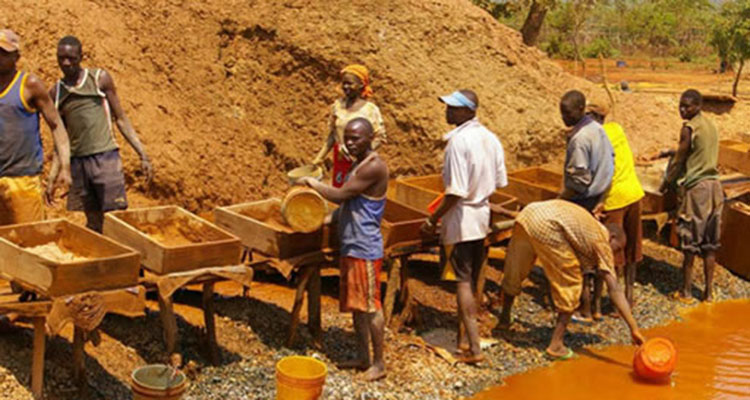
eBusiness Weekly

Often times portrayed negatively, artisanal and small-scale gold mining (ASGM) offers, potentially, exciting opportunities to propel sustainable rural economies.
Certainly, if not done responsible, ASGM can harm rural economies by disrupting agricultural activities, fuelling criminal activities and causing massive environmental damage.
Taking a leaf from the Africa Mining Vision (AMV), in Zimbabwe, ASGM can be integral part of rural economies promotion of knowledge of geological information and information management system; linkages, investments and diversification among others. After all, AMV is a blueprint agreed to by African Head of States at African Union in 2009 to guide transformative socio-economic development underpinned by transparent, equitable and optimum exploitation of Africa’s vast mineral wealth.
Knowledge of geological information and information management
Lack of geological information contributes to farmer — miner conflict and miner — miner conflict. It is common to find artisanal miners using gold detectors in farming areas leading to gold rushes which destroys arable lands. With better knowledge of geological information, there are better opportunities to dedicate areas that are viable for artisanal gold mining.
Already, countries like Tanzania have dedicated zones for artisanal mining. Simple but effective environment management practices will then be employed to rehabilitate the land for farming purposes instead of using complicated Environmental Impact Assessment (EIA) tool. Of course, our laws need to be reformed to accommodate artisanal mining.
Conflict can arise when artisanal and small-scale miners (ASMers) invite sponsors without a good understanding of their mineral wealth potential. In case of a huge find, ASMers feel short changed by sponsors leading to conflict on how to share the jackpot.
If miners have a good grounding on their geological assets, they become bankable and it helps the miners to anticipate windfall revenue and plan how to manage better their wealth. In turn, mitigating the stories of from riches to rags commonly found in the ASGM sector.
Infrastructure linkages
Command agriculture’s agenda is to ensure food security by winning off the country from reliance on rain fed agriculture. While underground water is major impediment to ASGM in most parts of the country. During the local economic and development indaba held in Bubi district in Matebeleland North province, on June 28 and 29, 2018, women miners expressed concern on lack of equipment to dewater their mines. There are opportunities, therefore, for command agriculture to support ASGM with water pumps in the same vein ensuring that water drawn out can be used for irrigation purposes in arable lands.
Benefits from such an intervention are numerous. It helps to improve farmer miner conflicts as farmers reap benefits of seeing ASGM as a water supply source for their farming activities. The nation stands to benefit from increased ASGM production which helps the country to generate much needed foreign currency. By encouraging usage of water pumped out by miners, in a way, offsetting depletion of underground water by mining activities.
Lessons can be learnt from several miners who have used underground water to successfully grow their agricultural business. In Bubi, Mr Ncube the chairperson of Bubi small-scale miners Association (BSSMA) is a classic example.
A beneficiary to the land reform process, Mr Ncube realised that there was an old gold mining shaft at his plot which was flooded with water. Mr Ncube is exploiting linkages between mining and agriculture successfully.
Investments linkages
Gold mining is a billion-dollar industry. Last year — 2017, ASGM contributed 53 percent to the country’s total gold production (24 843,87kg). It follows that over half billion dollars flowed to pockets of thousand artisanal and small-scale miners (ASMers).
Fundamentally, there is need to explore how well ASMers must are reinvesting this unsustainable income streams to promote the development of small to medium enterprises. Opportunities need to be tapped for local development of upstream or backward linkages like fabrication of equipment used in ASGM; and downstream or forward linkages like jewellery making.
Government must put in place a policy framework which enables local participation in the ownership structures of large scale miners considering incomes generated by ASMers. Yes, Zimbabwe must be open for business and locals should not be left out in this agenda in the name of attracting FDIs whilst overlooking local investment potential.
Diversification Linkages
Income generated from ASGM is also useful to diversify rural economies from unsustainable mining activities because minerals are a finite resource. Government, Civil Society Organisations (CSOs) and development partners must invest in educating ASMers the importance of diversifying from mining activities.
It is common to hear stories of ASMers who are poor now because their once rewarding mining pits are no longer profitable. As such, ASMers should be encouraged to invest in sustainable economic activities like agriculture and manufacturing. Cattle ranching, irrigation farming and manufacturing of personal protective equipment and school uniforms are some of the opportunities that can be tapped.
Conclusion
Some mineral deposits are not viable for large scale mining. ASGM, therefore, cannot be wished away if Zimbabwe is to enable optimal utilisation of the country’s mineral resources. Because ASGM is not sustainable, it offers a window of opportunity to leverage on over half a billion dollars generated by ASGM to promote linkages, investments and diversification for sustainable rural economies.
There is no need to look at ASGM and agricultural livelihoods in silos for instance. Opportunities to co-create value should be harnessed, command agriculture can spur growth of ASGM. Income generated from ASGM is a huge opportunity to encourage community enterprise development.



